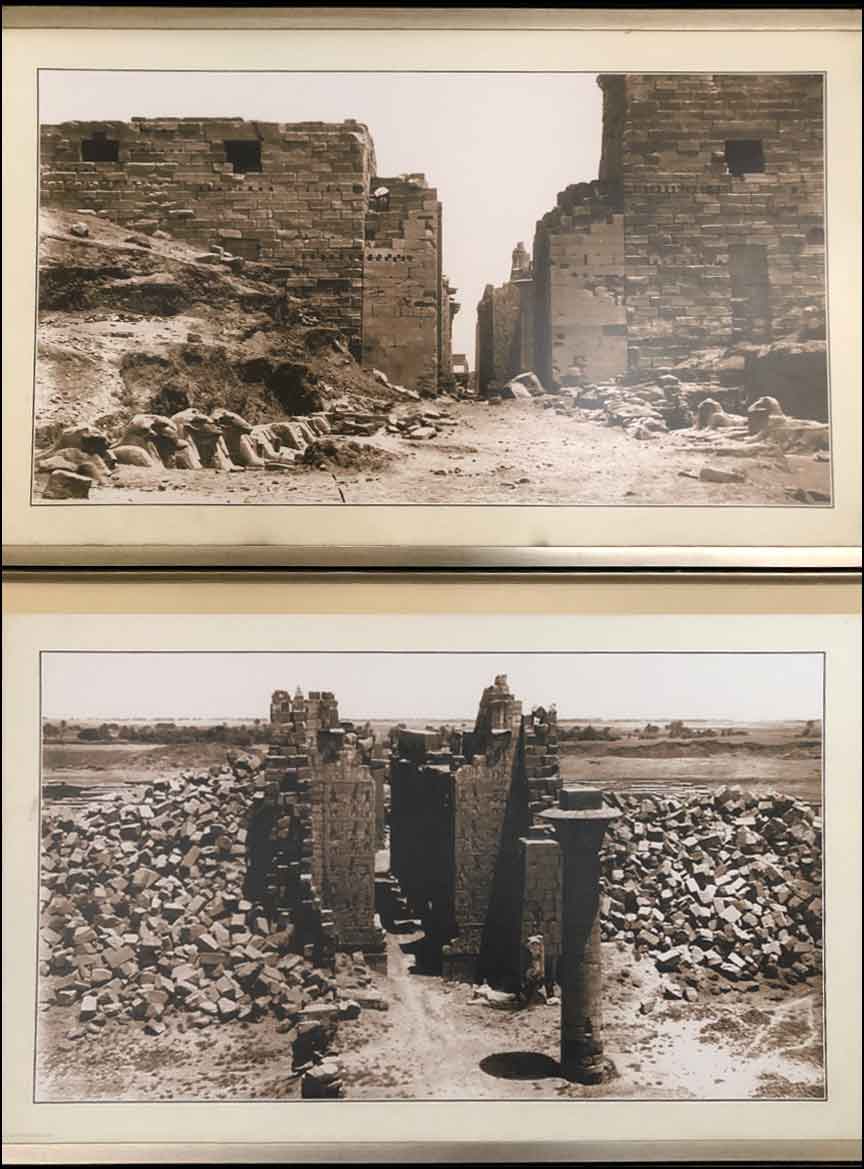
Packed for Posterity? An Hypothesis Regarding the Ancient and Intentional Burial of Egypt
By Robert M. Schoch and Catherine Ulissey
This article was initially posted on 6 October 2022 and updated December 2024.
Video presentation announcement, 14 October 2025: For those who enjoy reading, Katie and I offer this article below. In June of 2025, Katie gave her first public presentation regarding this hypothesis. In case you might like to view it, here is its link on YouTube.
- - - - -
While visiting Egypt in 2019, leading two tours for the not-for-profit Organization for the Research of Ancient Cultures (ORACUL), my wife, Catherine Ulissey (Katie), and I made what we believe is an extremely important archaeological observation regarding many of the ancient temples of Egypt. To phrase it concisely: The temples, rather than simply falling into ruins and being covered by the sand, dust, debris, and silt from the Nile, appear to have been intentionally and systematically buried. The question is, when did this intentional burial of ancient Egypt occur, and why? Before I address these questions (of course, those who follow my research may already recognize the direction in which I am headed), let us examine the Temple Complex of Karnak, where Katie’s first observations of this phenomenon were made.
Karnak
Located on the East Bank of the Nile, the Karnak religious complex was not a single temple, but a series of temples, halls, enclosures, obelisks, and a sacred lake that were built, modified, added to, rebuilt, and so on, continuously for thousands of years. According to the traditional Egyptological dating, the structures at Karnak range from Middle Kingdom times (circa 2040-1780 BCE) to Greco-Roman times (circa 332 BCE to 400 CE), with many of the most prominent portions dating to the New Kingdom (circa 1550-1070 BCE). However, one wonders if the origins of many of these structures date back to a much more remote period – even, perhaps, to the era that the dynastic Egyptians referred to as Zep Tepi or the first time. Katie and I are convinced, based on the evidence, that Zep Tepi can be placed in real time at the end of the last ice age, 12,000 years ago (see our book Forgotten Civilization: New Discoveries on the Solar-Induced Dark Age).
The observation of intentional burial at Karnak first struck Katie while viewing historical images on display along the walls of Karnak's Visitor's Center (see the banner image at the top of this page and also the illustration adjacent to this paragraph on the webpage). Katie noticed that the blocks in some of the images appear to be too massive to have been blown into position by the wind, as often occurs around abandoned structures in arid regions over vast expanses of time. (The Sphinx Enclosure on the Giza Plateau is but one simple example; in just a matter of decades it will fill with sand if left unattended.) It appears that the loose blocks were positioned around the temple walls, as if to fortify them. Notice the mountain of dirt piled above the ram-headed sphinxes that line the entryway to the complex (seen in the banner image at the top of this page). What is apparent in the images is not simply sand blown in through time. The blocks in this rubble pile are enormous, and the mountain of rubble is many meters high.

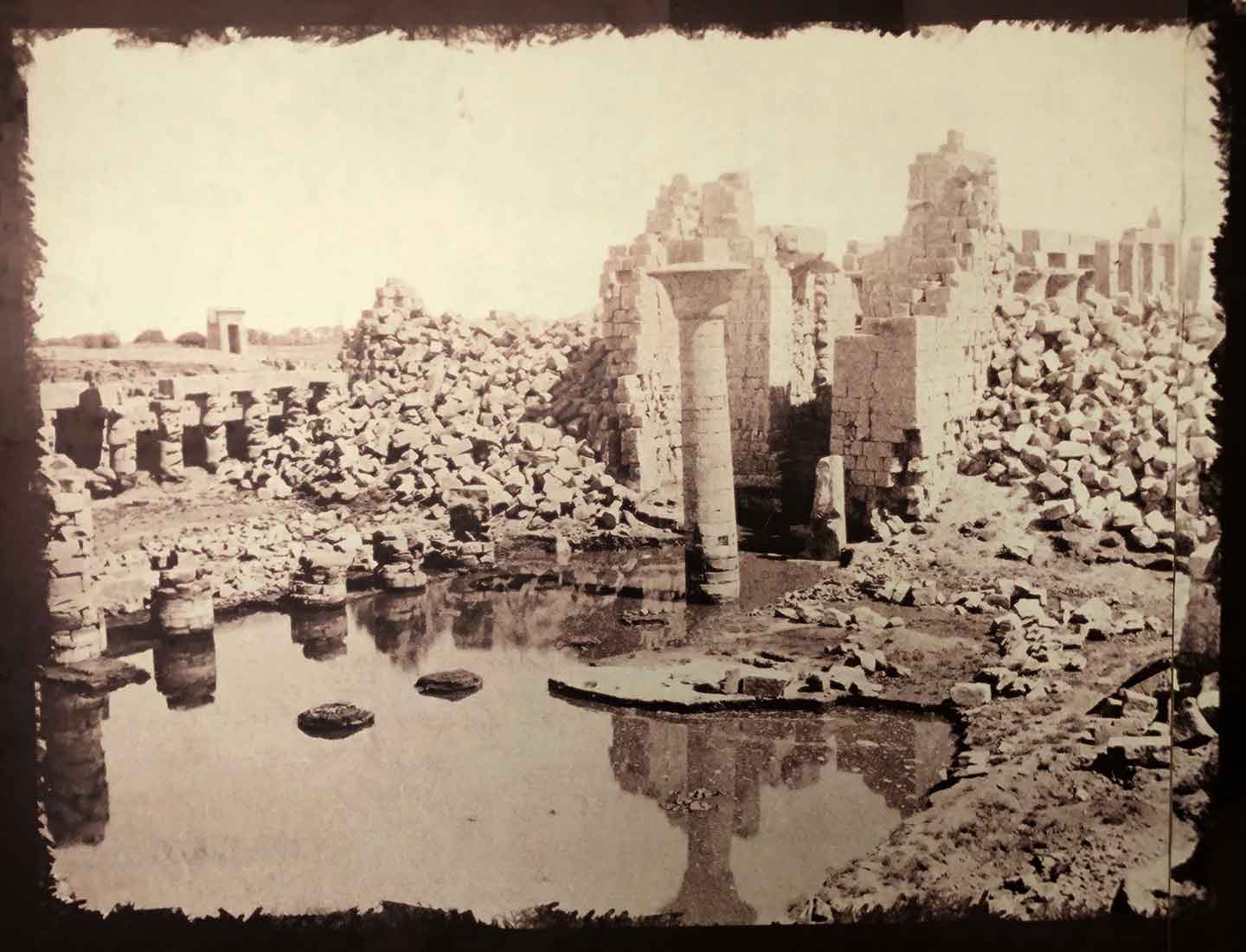
It appears from these images that colossal and towering megalithic temples, at some point in their history, suffered a catastrophe that caused destruction to them and to the entire site. Large rubble pieces (large blocks found in the vicinity) seem to have subsequently been piled up by ancient people against the towering temple walls and columns, as if to reinforce the remaining portions of the temple structure. Still later, dirt, fill, and the sands of time filled in the smaller gaps, creating a packed site. This process suggests initial human intention followed by natural processes.

On the opposite side of the towering walls that form the pylon (the walls featured in the banner image) one still finds neatly arranged ancient mudbricks piled against the back of the walls. Why would any pharaoh, be it Rameses III (reigned circa 1186-1155 BCE – who has been credited with some of the major building projects at Karnak) or some other pharaoh, pack mudbricks around this beautiful temple? Our speculation is that dynastic pharaohs did not initially construct this site. Rather, its origins go back to the time of Zep Tepi and portions of the complex were buried by more ancient people in an effort to protect their creations from scorching plasma (composed of fast moving electrically-charged particles) that was being ejected from our Sun during a series of solar outbursts that brought Zep Tepi to a close, and geologically and climatically ended the last ice age (see further discussion below).
In this context, it is interesting to quote the late John Anthony West’s perceptive observations and speculations concerning Karnak. The words and pagination below are taken from the 1995 edition of his book The Traveler’s Key to Ancient Egypt (Quest Books); however, they were first written in the early 1980s for the 1985 edition of his book.
From the Middle Kingdom on, almost every king left some mark of
his presence at Karnak. Sometimes no more than a single pillar or inscription remains – at other times
an entire temple. In some instances a later king has chiseled out the name of the earlier king
responsible for the original building and cut in his own. It is usually then claimed that the later
king ‘usurped’ the work of the earlier. Yet this matter is more complicated and more interesting than
that. These usurpations are selective. Only certain names in certain places have been effaced, and this
can only be deliberate, though done for reasons not yet fathomed.
(West, 1995, p. 241)
The powerful pharaohs of the New Kingdom were absolute monarchs
in total command of the resources of a rich empire. At a word the names of all the preceding columns
could have been scratched out had that been the intention. Ramesses II [reigned circa 1279-1213 BCE],
the greatest builder of all Egypt, was also the greatest ‘usurper,’ yet in innumerable instances he
did not touch the names or works of his predecessors; in many cases a cartouche will contain its
original name alongside one that has been ‘usurped.’
(ibid., p. 242)
Returning to the main temple [of Karnak], we come to the Second
Pylon built by Ramesses II,
with a center section restored by the Ptolemies. It is curious that here and elsewhere, the Ptolemies
undertook extensive repairs and some new building, yet left the columns and façade of the First Pylon
unfinished and did not even bother to remove the unsightly mud-brick ramp. There are a number of
instances in Egypt when it is clear that work has been deliberately left unfinished, not merely because
the responsible king or official died before it was completed. It is possible that the unfinished
business in the Great Court is one of these instances, particularly since it is the westernmost part of
the temple, where completion takes place. It is well within the parameters of symbolic Egyptian thinking,
in a temple consecrated to perpetual creation, to leave this section incomplete, awaiting the arrival
of another set of builders who never materialized.
(ibid., p. 246)
Here we see how J. A. West noticed some of the same lines of evidence: dynastic pharaohs
usurping
and reappropriating to themselves older structures, and mudbrick ramps
piled
against incredible stone walls and other stone structures (we suspect the ramps
were not, in many
cases, ever ramps at all, but instead were secondary materials packed around a structure to protect it).
Yet John Anthony West was not thinking in terms of perhaps the origins of these structures dating back
to well before dynastic times and only later being reappropriated by the dynastic Egyptians. Yes, he
was already thinking in those terms for the Great Sphinx, Osirion, and certain other structures.
However, in circa 1985 J. A. West and I had not yet met, we had not demonstrated together the hard
evidence for an older Sphinx, and sites such as Göbekli Tepe (dating back to the end of the last
ice age, to the time of Zep Tepi) had not yet been uncovered. J. A. West was a strong advocate of
the concept that high culture and civilization goes back in time thousands of years earlier than
the official textbook dogma regarding the beginnings of civilization a mere 5,000 or 6,000 years
ago. I wonder what he would make of the latest evidence and Katie’s observations and hypotheses.
In many respects Katie’s simple observation regarding the packing
of Egypt’s temples may be
as profound as the simple observation of Schwaller regarding the Great Sphinx. As West
(ibid, p. 140) noted,
[R. A.] Schwaller de Lubicz [1887-1961] observed that, in his
opinion, the dramatically
severe erosion on the body of the Great Sphinx could not be the result of wind and sand, as is
universally assumed [by Egyptologists and status quo historians], but was rather the result of
water.
J. A. West realized that water-weathering and erosion on the Great Sphinx suggested that it dated back to long before the Sahara Desert (which is only about 5,000 years old), and if this could be demonstrated, then the implications for the origins and antiquity of civilization would be profound. Yet he needed a geologist to confirm Schwaller’s observation and build upon it. Ultimately Schwaller’s simple observation led to a complete rethinking of the story of civilization, opening up vast new fields of study. Does Katie’s observation have the same potential? Do the initial ruins, the towering temples, of Karnak belong to Zep Tepi? Were these the original builders that J. A. West alluded to in the quotations above? We believe this is a very viable hypothesis. Yet this raises a perplexing thought; if the site’s origins go back to the last ice age, how or why was it demolished? By what force? Why did ancient people spend enormous amounts of time and energy to bury it? Furthermore, when was it finally abandoned such that the sands of time would ultimately bury it to such an extreme degree?
Here is our hypothesis in a nutshell: Studying both historic images from the nineteenth century and the remaining on-the-ground evidence, it strikes us that a more ancient temple complex stood majestically at Karnak in pre-history and experienced a cataclysm (thus the large broken blocks). It appears that various large blocks and stones were subsequently positioned around the surviving remnants of the once grand temple complex, and then fill was packed in and around the structures to protect them; during succeeding millennia, the loose sands of the desert environment and silt from the Nile filled in the smallest of areas.
Göbekli Tepe in Turkey – Precedence

In legal matters one looks to precedence. In archaeology one looks for other examples.
Such packing is perhaps not as enigmatic as it might first appear. It is not an isolated phenomenon
in the ancient world. Before looking at other examples we came upon in Egypt, we need to consider
the 12,000-year-old megalithic site of Göbekli Tepe in southeastern Turkey. Relative to my research
on the deep antiquity of civilization, Göbekli Tepe has played a critical role. In 1991, when I first
announced publicly my conclusion that the origins of the Great Sphinx go back to a much earlier period
than circa 2500 BCE (the then generally accepted date of the Great Sphinx), and by implication that
advanced culture and civilization must go back much earlier than circa 3500 BCE (the approximate date
for the origins of civilization then generally cited), there was outrage among most Egyptologists and
conventional archaeologists. I was asked to name another site that could support my contentions.
Unfortunately, at that time (1991-1992) I could not. However, in the middle 1990s the late Dr. Klaus
Schmidt of the German Archaeological Institute began excavating Göbekli Tepe. The site proved to not
only be incredibly sophisticated, with magnificently carved multi-ton T-shaped stone pillars arranged
in Stonehenge-like circles, but incredibly old – so old, that at first, I was skeptical regarding the
dating. Katie, John Anthony West, and I traveled to Turkey in 2010 to examine the site for ourselves
(Katie and I have visited Göbekli Tepe many times since). Speaking with Dr. Schmidt on-site at Göbekli
Tepe in 2010, he explained how radiocarbon analysis on secondary plasters combined with stratigraphic
correlations confidently dated the site back to nearly 12,000 years ago. Furthermore, the site was
intentionally buried well over 10,000 or 11,000 years ago – most likely at and just after the end of
the last ice age. Dr. Schmidt and I noted the diagnostic layers of rubble fill that had been used to
surround the pillars and hold them in position as the site was purposefully buried by humans. And Dr.
Schmidt and I discussed his analyses and radiocarbon dating of micro-stalagmites
and
micro-stalactites
that developed once the artificial fill was in place, confirming the very early
and intentional burial of Göbekli Tepe. Following Dr. Schmidt’s initial observations regarding the
intentional burial of Göbekli Tepe, the evidence of sites affiliated with Göbekli Tepe, such as
Karahan Tepe, indicates that they too were intentionally buried. Such purposeful burial, it would
seem, was a widespread phenomenon.
Unfortunately, Dr. Schmidt passed away prematurely in 2014. Since then work has continued at Göbekli Tepe, including further excavations and also building a new viewing platform that encircles the main excavated portion, and an awning that covers this area helping to protect it from the elements. Not surprisingly, for this is the nature of science, as work has proceeded at the site, various interpretations have been offered regarding the evidence. For instance, over the last few years Dr. Lee Clare has suggested that possibly Göbekli Tepe was not intentionally buried after all.

I am familiar with Dr. Clare’s arguments regarding the non-burial
of Göbekli Tepe, and
I do not believe they stand up to scrutiny. I am trained in stratigraphy and, based on the evidence,
I am convinced that the site was intentionally buried after toppled pillars were crudely re-erected
and secondary stone walls were built between the pillars and around the enclosures. I should point
out that the intentional burial of the site overall does not preclude some degree of natural slumping
and deposition later. In my assessment Dr. Schmidt, who spent years meticulously uncovering the site,
got it right; Göbekli Tepe was intentionally buried in ancient times. Turkish archaeologist Prof. Dr.
Necmi Karul, in his detailed paper titled Buried Buildings at Pre-Pottery Neolithic Karahantepe
(Türk Arkeoloji ve Etnografya Dergisi, Yıl: 2021, Sayı: 82), has confirmed such intentional
burial at Karahantepe, the so-called sister site
of Göbekli Tepe.

Returning to Egypt, to find packing at one site or two sites might be coincidence. To find
mudbrick packing at just about every temple we visited on our 2019 tours is another matter (see
further examples below), and the latter is grounds for strong hypothesis formation. To say, as
some Egyptologists have suggested, that the workers who built the breathtaking temples lived
in mudbrick structures is a not a cogent explanation. People who build skyscrapers today do not
live in the modern equivalent of mudbrick houses around the base of the building they are working on.
In all of the locations we came upon in Egypt during these recent trips, the mudbricks appeared
to be more protective mountains rather than residential structures. This brings us to another
explanation that has been proposed for the ubiquity of mudbrick structures in Egypt: the suggestion
that the sacred precincts of temple complexes were partitioned and surrounded by mudbrick walls.
Such mudbrick structures, some contend, were both symbolic (separating the sacred from the profane)
and practical (keeping out vandals, creating a fortified enclosure around a temple complex, or
simply served to keep back windblown sands). Although there may be some substance to such ideas
in particular cases, we do not believe that they adequately explain all cases of the presence of
mountains
of mudbrick, rubble, and packing found around so many ancient Egyptian sites.
Something more, more important and profound, is indicated by the evidence.
Though it was not a site that we visited during our 2019 tour, my mind immediately turned to a trip I had taken to Hawara, Egypt, a decade earlier with news anchor Lester Holt and an NBC film crew. They were filming a television special on the Mayan date of 2012 and wanted my on-site opinions regarding the ruins located at Hawara.
Hawara - Mudbricks on Top of Megaliths

Mudbrick Pyramidat Hawara.
Near the Faiyum Desert in Egypt, at a location known as Hawara, one finds an enormous mountain of mudbricks forming what is called a pyramid – specifically the pyramid of King Amenemhet III (of the Middle Kingdom, Twelfth Dynasty, reigned for about half a century, during the nineteenth- and early eighteenth-centuries BCE). What is striking about this structure is that this is not a traditional pyramid in any sense; rather it has the appearance of a large pile of mudbricks stacked up as if to protect something far more important and valuable beneath it. And indeed, megaliths can be seen beneath the mudbrick mountain.
In Greek mythology, Daedalus (known for crafting wings with which to fly) built a maze-like structure known as the Labyrinth on Crete to contain the Minotaur (part man, part bull). But the Cretan labyrinth was not the only one, or even the original labyrinth. Herodotus (fifth century BCE) and other Greek and Roman writers described a magnificent labyrinth in Egypt, containing three thousand rooms on two levels. Pliny the Elder (first century CE) related that the Egyptian labyrinth was already 3600 years old in his time. Hawara is the reputed site of this huge underground labyrinth that so many scholars and historians throughout history have spoken of.
It is believed that this labyrinth was a hall of records
, a repository
of ancient wisdom. The construction of the site itself would no doubt be inspiration for all.
Does this site in some way connect to the hall of records
believed to be located
beneath the paws of the Great Sphinx? At this time, and until the site can be carefully
excavated, one can only speculate. For those who are not aware of my research from the early 1990s,
I did seismically locate a cavity
beneath the Sphinx's left front paw, working with fellow
geophysicist Dr. Thomas Dobecki and the late John Anthony West. The regularity of this cavity suggests
that it is not a natural feature such as a cave, but rather something constructed by humans. I
believe that we (my colleagues and I) have now gotten to some of the answers surrounding the mysteries
of the Great Sphinx. I offer this article
(The Great Sphinx: She was the Lioness Mehit who Guarded an Ancient
Archive
), for those who might be interested in this aspect of my work.
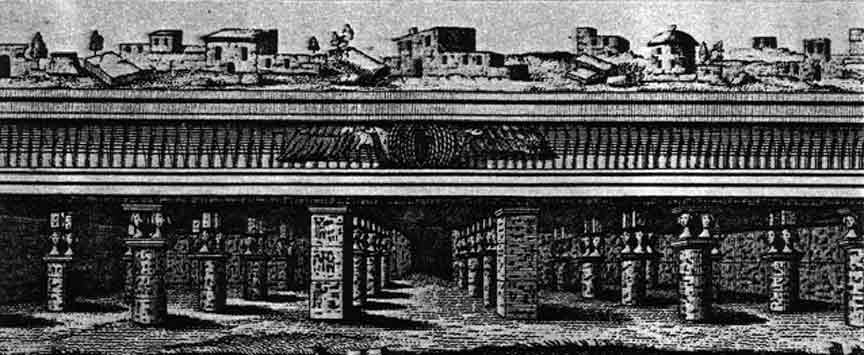
Returning to Hawara: As mentioned, I initially traveled there in 2009 with an NBC film crew, and Katie and I have returned in more recent years. The photographs posted with this article are from those trips, and what they show is remarkable. No true pyramid comparable to those of Giza, but rather a mountain of mudbricks with megalithic structures beneath. Megaliths strewn on the top of the sand. And the sand, with its uneven topography (hilly and pockmarked, giving the appearance of an enormous egg carton), suggests to us that something substantive lies beneath. Did King Amenemhet III construct the mudbrick mountain? Did he have anything to do with the megaliths beneath it? Or did he appropriate the complex to himself and reuse it?


Katie and I suggest that it is possible that the mudbricks at Hawara go back to a more ancient time and were placed there to protect the structure(s) beneath. Sand can be harmful to stone; it can certainly erode it. However, the research we have been doing regarding solar outbursts at the end of the last ice age seems to offer a more plausible explanation.
The Temple of Esna
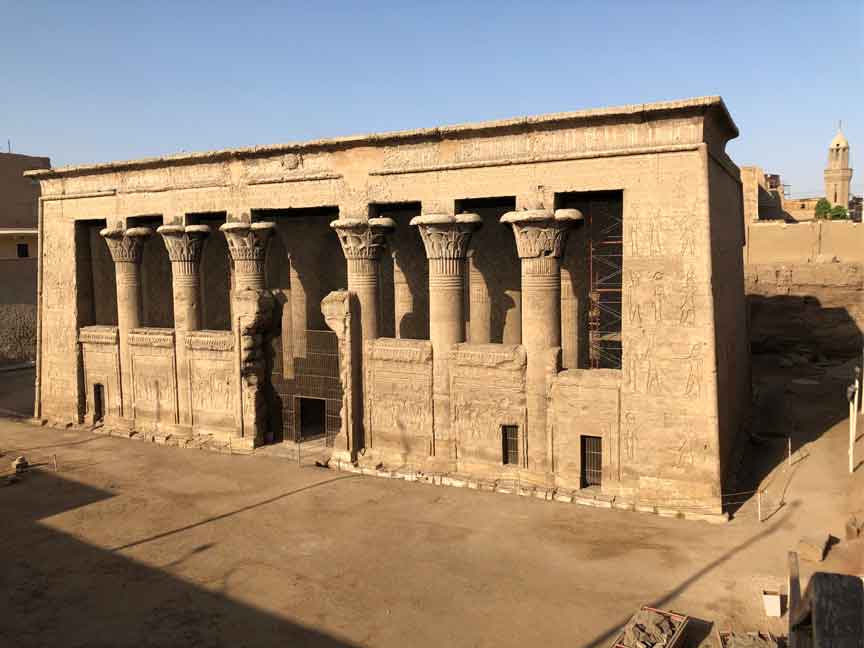
The city of Esna, in Upper Egypt south of Luxor, is the site of a remarkable temple complex, the majority of which to this day remains buried. At first, our impression was that its burial was due to silt from the Nile. However, during our 2019 visit we were able to more carefully view what was behind the temple: Not just silt, but ancient mudbricks right down to the ground level!
The Temple of Esna was built close to the river on the floodplain and it has long been asserted that apparently thousands of years of Nile-deposited sediments built up and filled in around the structure, such that in the time of Napoleon’s invasion of Egypt (1798-1799) only the tops of the highest columns and the roof of the temple were visible. The rest of the temple was under nine meters or more of mud and debris. Since Napoleon’s time the Hypostyle Hall, consisting of its walls, complete roof, and two-dozen columns – all covered with magnificent relief carvings – has been excavated, but the majority of the temple complex, and undoubtedly many other ancient structures, remain buried under the modern city. To view the Hypostyle Hall, one literally descends via a steep stairway into a pit below street level.
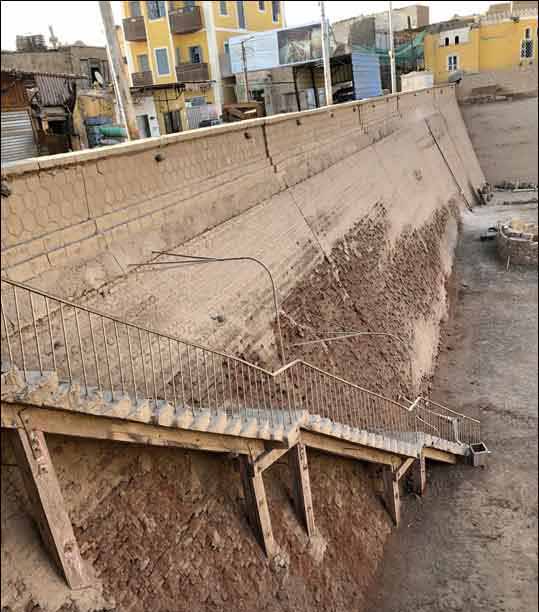
The Temple of Esna is dedicated to a primordial creator god represented by, or associated with,
the god Khnum (often depicted with a ram’s head, he was the potter
who brought forth humankind
and all living creatures from the clay), and his consort Neith (sometimes viewed as comparable to
the Greek Athena). The majority of visible carvings on the excavated portions of the temple have
been conventionally dated to Ptolemaic and Roman times (circa middle second century BCE to middle
third century CE) and include astronomical scenes, complex rituals, and inscriptions that have
thus far eluded full interpretation. However, based on fragmentary older inscriptions, it is
evident that Esna dates back thousands of years earlier. One wonders exactly how far back it
could go. It is distinctly possible that the relatively recent Greco-Roman construction and
inscriptions are an overlay on, and additions to, much older structures. This hypothesis of
an older structure and origin for Esna is reinforced by our observation of not simply layers
of Nile silt around the temple, but also piled ancient mudbricks that have been excavated in
modern times and were apparently packed close to or right up against the stone temple, even at its lowest
levels. This is the same pattern we observe elsewhere in Egypt. Is this more evidence of remains from
the time of Zep Tepi?
The topographic / stratigraphic level alone, well below the level of the current modern city of Esna, suggests great antiquity. Furthermore, Greco-Roman carvings and inscriptions at Esna do not prove that this is the origin of the structures we see. As Katie and I observed when exploring and studying the rock-cut structures and underground cities of Cappadocia (Anatolia, in modern Turkey), ancient structures were used and reused. In Cappadocia it is quite evident in some cases that Byzantine-era churches were created by reusing much older chambers and enclosures hewn into the rock; one can observe on the walls the layers of paint and plaster covering over even older decorations and the reworking of older structures is obvious to the trained eye. We suggest that a comparable situation occurs at Esna and other sites in Egypt. The sites were used, packed over and protected, re-discovered in some cases during dynastic and Greco-Roman times, and reused. It is not surprising that dynastic pharaohs, Ptolemaic kings, and Roman emperors carved their names into the older structures.
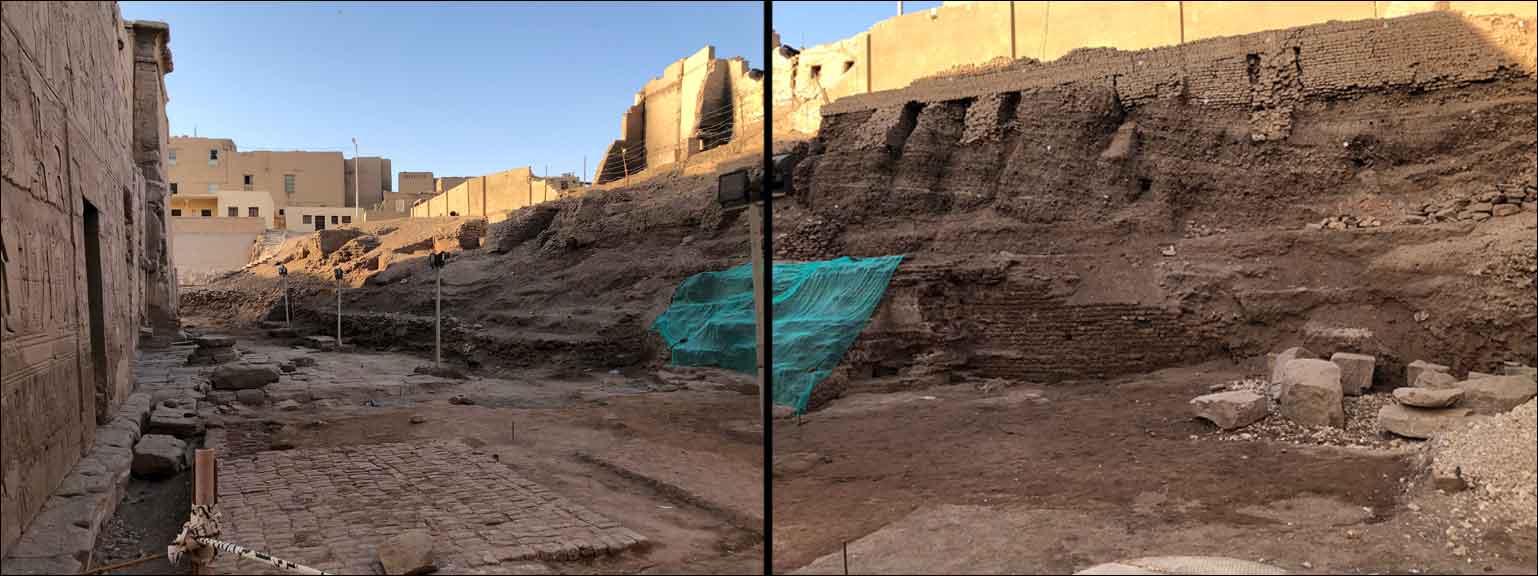
Kom Ombo
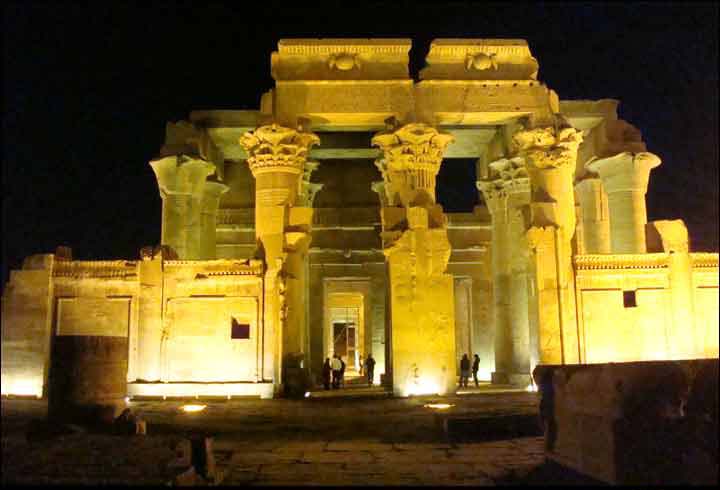
According to standard Egyptologists, Kom Ombo is a Ptolemaic-Roman dual Temple dedicated to both the crocodile-headed Sobek and the falcon-headed Haroeris. Sobek, allied with Set (who killed Osiris and fought Horus), was a God of Death and what simplistically might be seen as evil, yet not evil in any absolute sense, but the other side of good; one way of thinking (the Egyptian way) is that without evil there cannot be good or redemption, and without death there cannot be resurrection and life. Haroeris was a form of Horus, known as Horus the Elder, and in some ancient texts was equated with Day while Sobek and Set were associated with Night.
The Kom Ombo ruins are beautifully illuminated at nighttime, and perhaps for this reason the site is often visited by tourists during evening hours. However, in 2019 our tour group had the opportunity to visit these ruins during daytime hours.

Seeing Kom Ombo in its entirety, not just the portions illuminated at night, was an exciting prospect. After introducing the temple to our guests in the usual manner, while everyone took time to absorb the magnificence of the architecture and capture photographs, Katie and I quickly dashed to the perimeter of the temple complex. We found, as we anticipated we would, an apparent mountain of mudbricks cleared away from the temple ruins, but evidence of the mudbricks remains around the perimeter of the general site. A pattern was becoming more and more apparent, and we were certain it was not because every pharaoh built magnificent temples only to pile mudbricks around and on top of them. The original sites, we reasoned, may be much older, were buried for protection in prehistory, and Dynastic Egypt arose around them, appropriated the then already ancient ruins, restoring, rebuilding, and adding to much earlier structures.


The Osirion

The Temple of Osiris at Abydos, attributed primarily to Seti I (reigned circa 1294 or
1290-1279 BCE) and his son Ramesses II (reigned circa 1279-1213 BCE), is a beautiful temple
with a strange L-shaped ground plan. Behind the main temple, at a much lower level (indeed,
it sits in a hole
) lies the incongruous megalithic structure known as the Osirion
(the so-called Tomb of Osiris; the name is spelled a number of different ways in the literature).
The Osirion was completely unknown in recent times until it was discovered by modern excavations.
The standard story is that the Osirion was buried by Nile silt and mud over the millennia, as has also been suggested for the Temple of Esna (see above). However, if one looks at the upper right portion of the image accompanying this section, one can see a layer of smaller rock rubble and debris, which suggested to us that this is another instance of a very ancient structure that was packed for posterity.
Here I would like to point out that the Osirion is a structure that John Anthony West and I discussed,
and puzzled over, for decades. In many ways it is so out of place in terms of standard Egyptological
thought, built at a much lower level than the temple in front of it. Together we speculated that it
must surely be a much earlier structure, one that goes back to the same time as the origins of the
Great Sphinx (that is, circa 10,000 BCE). Indeed, the so-called Sphinx Temple and Valley Temple at
Giza located in the immediate vicinity of the Great Sphinx were built from huge megalithic blocks
carved out when the body of the Sphinx was freed from the rock, so these two temples
have their
origins at the same time as the origins of the Great Sphinx. Stylistically, the Osirion is remarkably
similar to the Sphinx and Valley Temples. J. A. West and I noted these features in
the 1993 NBC documentary
The Mystery of the Sphinx. The hypothesis of ancient packing only serves to reinforce the idea that
the Osirion does in fact date back to the time of Zep Tepi.
Mudbricks Around Dendera
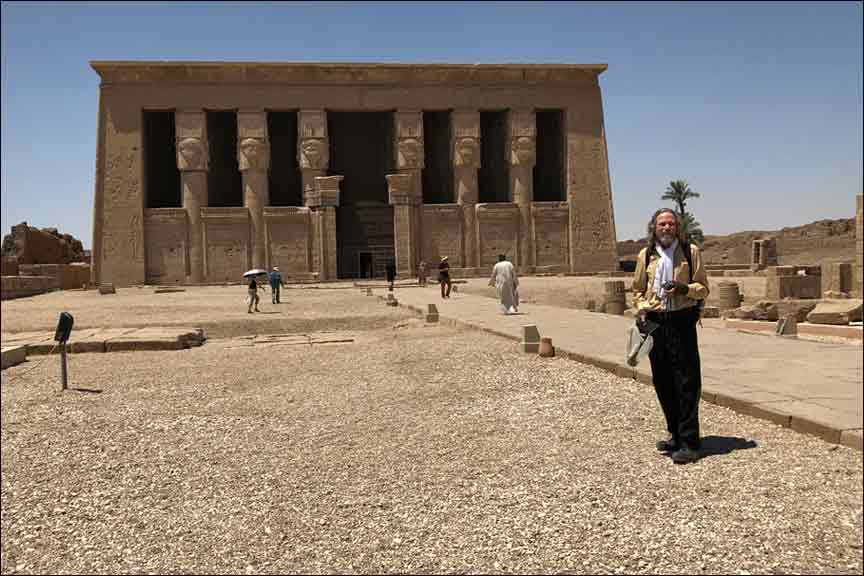
The current Temple at Dendera, dedicated to Hathor, dates primarily to the first century BCE
according to standard Egyptology. However, the site itself is generally acknowledged as being much
more ancient, and inscriptions from some two thousand years ago state explicitly that the current
temple had been built (or, we suggest, re-built) based on plans that were thousands of years old –
that is, we believe, dating back to Zep Tepi times. Corroborative evidence, we suggest, for this
very ancient tradition of a very ancient temple at Dendera includes the mudbrick packing (often
referred to as walls
) that surround and embrace the site. (On a personal note, since the first
time I visited Dendera in the early 1990s I have always felt an affinity and attraction for the
site. To put it simply, it is one of my favorite temples in Egypt. On the ceilings are incredible
renditions of the stars and zodiac, and here we also have images that memorialize events of deepest
antiquity. At Dendera, in the so-called secret crypts
, ancient knowledge and wisdom is carved
on the walls, knowledge that was reputedly passed down over the millennia. The hypothesis of reuse and
repacking, combined with the dynastic traditions that the origins of this temple go back to a time
before time, shed new light on this sacred site.)

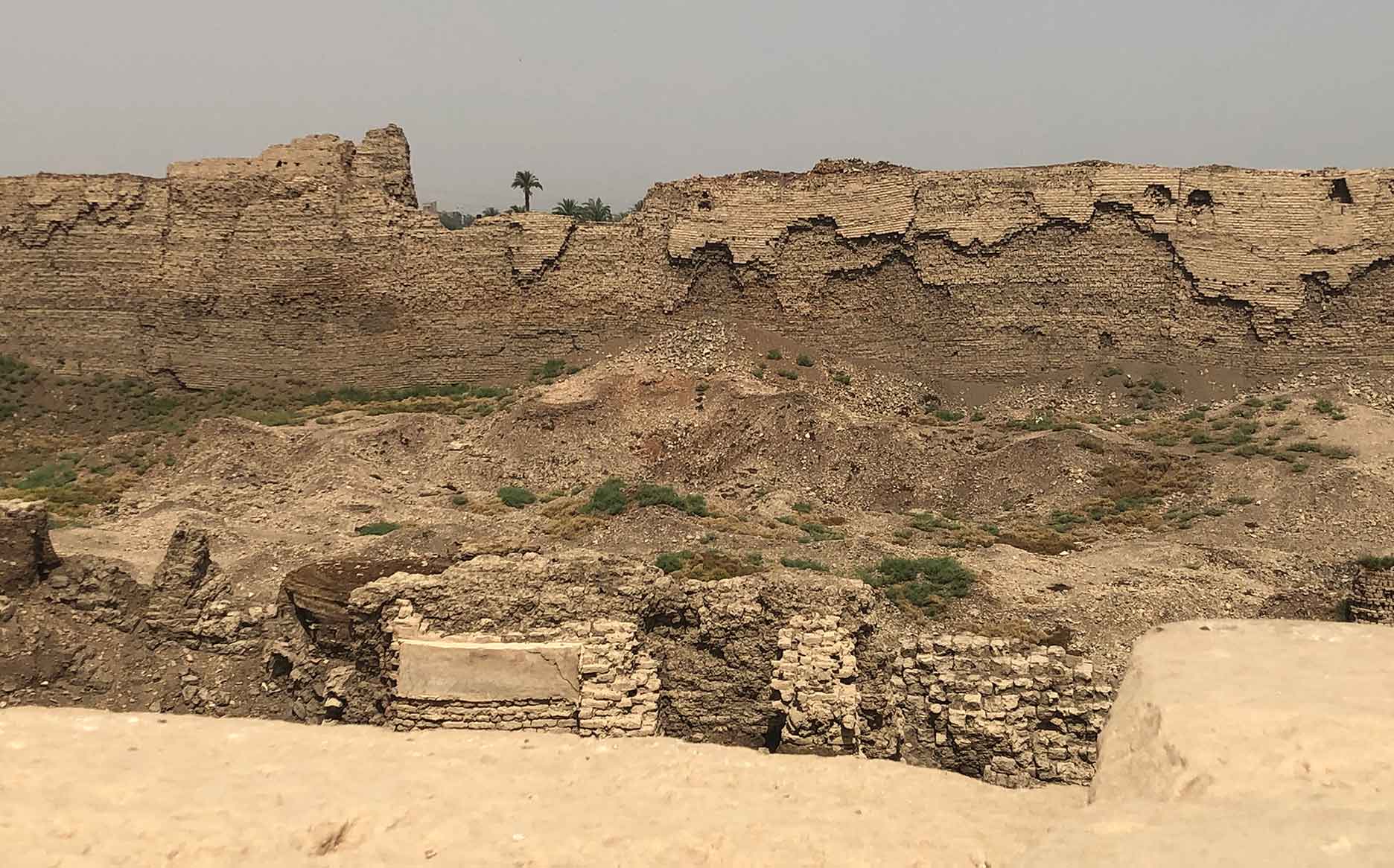
Mudbricks Around Edfu

According to the standard story, the Ptolemaic Temple of Edfu (dating to the third through
first centuries BCE) is dedicated to Horus (son of Osiris and Isis) in his role as avenger of
his father's death. The legend of Osiris, Isis, Horus, and Set (Seth) is one of the central
myths of ancient Egypt. Often referred to as a book in stone
due to the numerous inscriptions
on its walls, the Temple of Edfu is one of the best preserved in Egypt; here even the ancient
mudbricks have been preserved by modern Egyptologists and contemporary authorities. Look closely,
though. The piles of mudbrick do not appear to be homes, residential constructions, or perimeter
walls that date to Ptolemaic times; rather they give the impression of literal packing and
protection surrounding the temple complex, the origins of which we suspect goes back to pre-SIDA
(Solar-Induced
Dark Age) times, a term that Katie and I coined for the period spanning the end of the last ice
age, circa 9700 BCE, to the reemergence of civilization in circa 3500 BCE. Please see the section
below for our hypothesis.

2024 Additions To This Article

templethat remains behind it; the stone structures there still have mudbricks touching and surrounding them.
Almost everywhere one looks in Egypt one can find mudbricks surrounding the most remarkable
structures from antiquity. Though not depicted photographically in this short article, Elephantine
Island must be mentioned. It is replete with what we call mudbrick packing
. The island appears
to this day to still be in the process of being dug out
.
The Bent Pyramid: During a vist to Egypt in 2023, Katie and I could not help but notice that behind
the massive Bent Pyramid a collection of small stone structures referred to as a temple
remain. (It seems that
if archaeologists or Egyptologists do not know what something they uncover once was, they choose one of two options for
it: it becomes either a temple
or a tomb
.) Surrounding the stones, and indeed still directly touching them
in several cases, can be seen mudbricks. In our assessment this is just another example of what we believe to be ancient
packing, covering, or burial of older structures. We put forth an hypothesis above, and everywhere we look
in Egypt we feel there is evidence to support it.
The Great Sphinx: Whether, or not, it pertains to the current hypothesis, it is interesting to note that in the Sphinx Enclosure there is found the remains of a mudbrick wall on the ledge above the Sphinx. Were there once structures in the Enclosure that were covered or protected by mudbricks? What are the true origins of this remaining mudbrick wall? Interestingly, the mudbrick wall seems to stop at the same position as the fissure through the back of the Sphinx (that is, the end of the mudbrick wall is located at the line that marks the path of the fissure through the body of the Sphinx), a fissure that may have possibly been cut or widened by a plasma strike during a solar outburst, as occurred at the end of the last ice age. And, based on the evidence, I am convinced that the origins of the Great Sphinx date back to the end of the last ice age (the head is a dynastic re-carving; originally the statue had the head of a lioness).

Our Hypothesis
At the end of Earth's last ice age (circa 9700 BCE), our planet was hit by the destructive
forces of a massive solar explosion, a micronova that unleashed coronal mass ejections (CMEs)
and associated phenomena. This scorching event caused the rapid melting of glacial ice sheets,
global and catastrophic flooding, torrential rains from the moisture pumped into the atmosphere
(thus the heavy rains that fell upon and scarred/fissured the Great Sphinx and its enclosure).
Many large mammals went extinct due to high levels of radiation, humans included. Survivors
sought shelter in caves and beneath Earth's surface – the underground cities of Cappadocia, which we
believe originated at this time (although they were reused later), are a prime example.
We suspect that the areas in Egypt now referred to as the Valleys of the Kings, Queens, and Nobles
were comparable structures which had their origins during this remote period (and were likewise
enlarged and reused by later peoples, including the dynastic Egyptians). The high civilizations
of the late ice age were decimated. Those who survived witnessed a golden age of high knowledge and
sophistication coming to an end. These were neither simple nor primitive hunters and gatherers.
Survivors did what they could to preserve the greatness of their monuments and history by intentionally
physically packing and burying their temples
(these structures may not have been temples in
a modern sense, but something more, perhaps akin to modern university complexes, libraries, and museums
– that is, centers of knowledge). The survivors attempted to record and preserve the knowledge of Zep
Tepi. This article focuses on the apparent packing of various structures across Egypt, with reference
to the rigorously excavated site of Göbekli Tepe in Turkey where the intentional burial in very ancient
times is well-attested to by the physical evidence. Göbekli Tepe remained covered with protective materials
for over 10,000 years and therefore was in relatively pristine condition when excavated. The sites in
Egypt, however, have been lived in for thousands of years, with one pharaoh after the next
re-appropriating what they wished. For this reason, the evidence is less clear in Egypt and,
despite the excavations and research that have been carried out along the Nile for centuries,
the profound implications of the intentional burial of so many sites has been obscured.

cycles of civilizationwe now have evidence for (one that ended with the end of the last ice age and our current cycle of civilization that began 5,000 to 6,000 years ago).
We believe the intentional burial of ancient Egypt, and specifically the mudbrick packing seen across the land at so many temple complexes, bears witness to an advanced people recognizing that their civilization (during the time of Zep Tepi) was collapsing due to planetary and solar system changes that were occurring and were beyond their control. Despite the cataclysm, they sought to preserve what they could of their existence.
As we begin to lift the veil of the intentional burial of some of the most magnificent structures ever created by humanity, a new and powerful message from a more ancient Egypt – from the time of Zep Tepi – emerges. This, we believe, is the message that the ancient of ancients left for posterity.
A Warning for Today:
Based on ice core and sediment core records, the Sun remained relatively calm and stable for many
millennia (for eight thousand years or more, with a few smaller interspersed eruptions). However, over
the last two centuries, our Sun has been
exhibiting the same signs of extreme activity (including the Carrington Event of 1859) that it did
nearly 12,000 years ago at the end of the last ice age. It would be prudent for us to learn from the
past and prepare for the future. Currently we lack the knowledge to predict precisely when the next
major solar outburst might occur; analyzing the data, I have concluded that it could take place at
any time, be that next year or twenty-five years from now. Ancient traditions around the world suggest
that there are cycles of ups and downs
for humanity ranging from Golden Ages
to periods
of warring and depravity (often referred to, following Hindu tradition, as the Kali Yuga). Furthermore,
most ancient and indigenous traditions agree that for the last few millennia (or longer) we have been
in the bottom of the cycle. Some people suggest that a major solar outburst may have a cleansing
effect, destroying much of that which is the worse of modern society and allowing for a re-start of
civilization. There may be truth to this, as modern civilization, so dependent on electricity and
electronics, could be decimated. A new world will arise from the remains of the old, but what it
will be like depends on how we prepare now for the next cataclysm.
For more information on the intentional burial of Göbekli Tepe, as well as numerous other topics related to the end of the last ice age and the demise of an early cycle of civilization at that time (including global plasma petroglyphs, Easter Island's rongorongo script connected to plasma, etc.), we recommend the expanded (2nd) edition of Forgotten Civilization, subtitled New Discoveries on the Solar-Induced Dark Age.
We express our thanks to Mohamed Ibrahim, with whom we traveled in Egypt during the summer of 2019 (he was the official Egyptian tour guide for the ORACUL tour, as required by the Egyptian authorities), and with whom we shared this discovery at that time. As we traveled through the country with him, we were able to examine carefully and discuss more thoroughly this observation and hypothesis than if we (Katie and I) had been traveling entirely on our own.
ABOUT THE AUTHORS
Robert M. Schoch, Ph.D.

A full-time faculty member at Boston University since 1984, Dr. Schoch earned his Ph.D. (1983) in Geology and Geophysics at Yale University. In the early 1990s, Dr. Schoch’s geological analyses of the Great Sphinx demonstrated that the statue is thousands of years older than the conventional dating of 2500 BCE, bringing him international fame and recognition. His assertion that there was an earlier cycle of civilization before civilization is supposed to have existed, though attacked by many members of the Egyptological and archaeological establishments, has stood the test of time. Stunning confirmation of Dr. Schoch’s view has come with the discovery of the highly sophisticated 12,000-year-old site of Göbekli Tepe in southeastern Turkey. In recent years, further data and reanalysis of his previous work has led Dr. Schoch to conclude that the origins of the Sphinx go back millennia further than he first proposed; he now places the origins of the Great Sphinx at about 12,000 years ago. Dr. Schoch is the author of numerous books and articles, both academic and popular, including Forgotten Civilization: New Discoveries on the Solar-Induced Dark Age (with Catherine Ulissey; Inner Traditions, 2021; this is a revised and expanded edition of the original 2012 edition). He has reached audiences around the world via television, radio, live presentations, and the Internet (the Emmy-winning documentary The Mystery of the Sphinx, which first aired on NBC, remains a favorite among audiences). In recognition of his scientific contributions to the study of ancient civilizations, in 2014 Dr. Schoch was awarded the title of Honorary Professor of the Nikola Vaptsarov Naval Academy in Varna, Bulgaria. Dr. Schoch’s website is: www.robertschoch.com . For more, please see the About page of this website.
Catherine Ulissey
Katie found her early years shaped by dance. Classically and conservatory-trained by the age of sixteen, she began performing professionally (and internationally) with ballet companies, including the Maryland Ballet and The Eliot Feld Ballet Company in NYC. As Ballet Mistress and a soloist performer with Eliot Feld's company, she had the opportunity to work with other prominent New York choreographers such as David Parsons and the Pilobolus team. Subsequently, Katie performed in a number of Broadway musicals, including the Tony Award-winning New York Shakespeare Festival production of The Mystery of Edwin Drood and the original cast of Andrew Lloyd Webber's The Phantom of the Opera. In 2002, following a 20-year stage career, Katie attended Emerson College in Boston, earning a B.A. in Visual and Media Arts (summa cum laude). Post-graduation, she has stayed connected to her dance roots by teaching ballet – formerly for the Harvard University Dance Program (for sixteen years) and the Boston Ballet School, and more recently for Wellesley College, where she has instructed students since 2005. Katie spent her early childhood growing up in Saudi Arabia and there, through her parents, was introduced to and fell in love with the ancient mysteries. She met her husband, Dr. Schoch, while attending a conference on the topic in 2007. In January 2010 (with the help of friends and dignitaries), they were married on Easter Island. Inspired by her husband’s research from the moment she learned of it, she is enormously proud to now contribute to it. In addition to her contributions to Forgotten Civilization, Katie has worked with her husband and illustrator Lisa M. Perkins to create a children's book series focusing on the ancient mysteries. Book one of this series, Adriana and the Ancient Mysteries: The Great Sphinx, was initially published in German (in 2021) and then subsequently in Italian (in 2022). In June of 2024 the book was revised and released in English. Please see the Publications page of this website for more on this children's book, or visit her page of this website for more on Katie. A bio with some of Katie's more notable work in theatre is posted on the Wellesley College website.

